目录
2.9 StringBuilder和StringBuffer
一、String概念及创建
1.1 String概念
Java中字符串是由字符组成的一个字符数组,是复合数据类型,也是一种引用类型。所有涉及到可能修改字符串内容的操作都是创建一个新对象,改变的是新对象;String类中的字符实际保存在内部维护的value字符数组中
1.2 String的创建
String类提供的构造方式非常多,常用的就以下三种:
//常量字符串构造
String str="hello word";
System.out.println(str);
//new String对象
String str1=new String("hello!");
System.out.println(str1);
//用字符数组构造
char[] chars={'h','e','l','l','o',' ','w','o','r','l','d'};
String str2=new String(chars);
System.out.println(str2);

注意:String是引用类型,内部并不存储字符串本身,而是存储一个地址,在Java中“”引起来的也是String类型对象。
String s1="hello";
String s2="world";
String s3=s1;
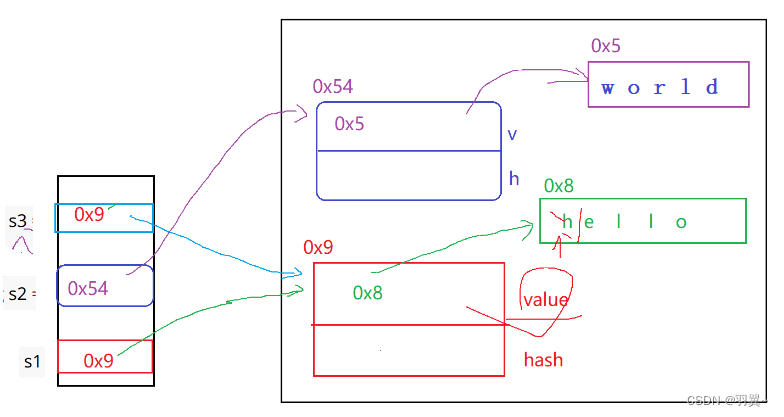
二、String常用方法
由于字符串是不可变对象, 不是修改当前字符串, 而是产生一个新的字符串
2.1 String对象的比较
字符串的比较是常见操作之一,Java中提供了4中方式:
1. ==比较是否引用同一个对象。
int a=5; int b=10; //基本数据类型变量,==比较两个变量的值 System.out.println(a==b); //引用类型变量,==比较两个引用变量引用是否为同一对象 String s1="hello"; String s2="world"; String s3="hello"; String s4=s1; System.out.println(s1==s2); System.out.println(s1==s3); System.out.println(s1==s4);
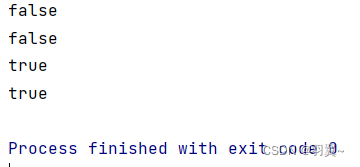
2.boolean equals(Object anObject) 方法,比较字符串的内容是否相等,返回的是boolean类型。
String s1 = new String("hello");
String s2 = new String("hello");
String s3 = new String("Hello");
//s1、s2、s2引用对象不同,但s1和s2内容相同
System.out.println(s1.equals(s2));
System.out.println(s1.equals(s3));
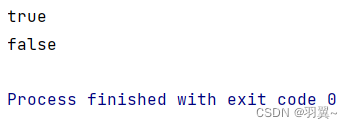
3.int compareTo(String s) 方法
compareTo返回的是int类型,比较方式: 先按照字典次序大小比较,如果出现不等的字符,直接返回这两个字符的大小差值;如果前k个字符相等(k为两个字符长度最小值),返回两个字符串长度差值。
String s1=new String("abc");
String s2=new String("ac");
String s3=new String("abc");
String s4=new String("abcdef");
System.out.println(s1.compareTo(s2));//输出字符差值-1
System.out.println(s1.compareTo(s3));//输出0
System.out.println(s1.compareTo(s4));//输出长度差值-3
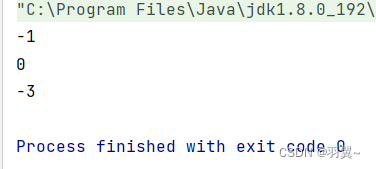
4. int compareToIgnoreCase(String str) 方法:与compareTo方式相同,但是忽略大小写比较。
String s1=new String("abc");
String s2=new String("ac");
String s3=new String("ABC");
String s4=new String("abcdef");
System.out.println(s1.compareToIgnoreCase(s2));//输出字符差值
System.out.println(s1.compareToIgnoreCase(s3));//输出0
System.out.println(s1.compareToIgnoreCase(s4));//输出长度差值
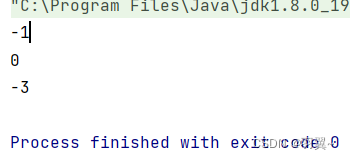
2.2 字符串查找
字符串查找也是字符串中非常常见的操作,String类提供的常用查找的方法:
| 方法 | 功能 |
| char charAt(int index) | 查找并返回index位置上字符,如果index为负数或者越界,抛出异常 |
| int indexOf(int ch) | 查找并返回ch第一次出现的位置,没有返回-1 |
| int indexOf(char ch, int fromIndex) | 从fromIndex位置开始查找ch第一次出现的位置,没有返回-1 |
| int indexOf(String str) | 查找并返回str第一次出现的位置,没有返回-1 |
| int indexOf(String str, int fromIndex) | 从fromIndex位置开始找str第一次出现的位置,没有返回-1 |
| int lastIndexOf(char ch) | 从后往前查找,返回ch第一次出现的位置,没有返回-1 |
| int lastIndexOf(int ch, int fromIndex) |
从fromIndex位置开始,从后往前找ch第一次出现的位置,没有返回-1 |
| int lastIndexOf(String str) | 从后往前找,返回str第一次出现的位置,没有返回-1 |
| int lastIndexOf(String str, int fromIndex) |
从fromIndex位置开始找,从后往前找str第一次出现的位置,没有返回-1 |
String s1="aabbccaabbcc";
System.out.println(s1.charAt(2)); //b
System.out.println(s1.indexOf('c')); //4
System.out.println(s1.indexOf('b',4)); //8
System.out.println(s1.indexOf("bbcc")); //2
System.out.println(s1.indexOf("bcc",4)); //9
System.out.println(s1.lastIndexOf('c')); //11
System.out.println(s1.lastIndexOf('c',6)); //5
System.out.println(s1.lastIndexOf("bcc")); //9
System.out.println(s1.lastIndexOf("bcc",8)); //3
2.3 转化
1.数字和字符串转化 String.valueOf、Integer.parseInt、Double.parseDouble
//数字转字符串
String s1=String.valueOf(15); String s2=String.valueOf(1.5); String s3=String.valueOf(true); System.out.println(s1); System.out.println(s2); System.out.println(s3);

//字符串转数字,Integer、Double是Java中的包装类型
int s1=Integer.parseInt("15");
double s2=Double.parseDouble("1.5");
System.out.println(s1);
System.out.println(s2);
2.大小写转换 toUpperCase、toLowercase
public static void main(String[] args) {
String s1="abc";
String s2="ABC";
//小写转化为大写
System.out.println(s1.toUpperCase());
//大写转化为小写
System.out.println(s2.toLowerCase());
}

3.字符串数组转化 toCharArray、new String()
public static void main(String[] args) {
String s1="hello";
//字符串转化为字符数组
char[] ch=s1.toCharArray();
for (char ch1:ch) {
System.out.println(ch1);
}
//字符数组转化为字符串
String s2=new String(ch);
System.out.println(s2);
}
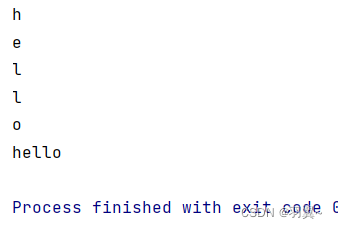
4.格式化 format
public static void main(String[] args) {
String s=String.format("%d-%d-%d",2023,8,7);
System.out.println(s);
}

2.4 字符串替换
使用一个指定的新的字符串替换掉已有的字符串数据。
| 方法 | 功能 |
| String replaceAll(String regex, String replacement) | 替换所有的指定内容 |
| String replaceFirst(String regex, String replacement) | 替换首个指定内容 |
public static void main(String[] args) {
String s1="helloworld";
String s2=s1.replaceAll("|","_");
System.out.println(s2);
String s3=s1.replaceFirst("|","_");
System.out.println(s3);
}

2.5 字符串拆分
可以将一个完整的字符串按照指定的分隔符划分为若干个子字符串。
| 方法 | 功能 |
| String[] split(String regex) | 将字符串全部拆分 |
| String[] split(String regex, int limit) | 将字符串以指定格式拆分为limit组 |
public static void main(String[] args) {
String s1="hello word good afternoon";
String[] s2=s1.split(" ");//全部拆分
for (String str:s2) {
System.out.println(str);
}
}
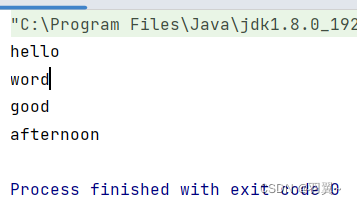
public static void main(String[] args) {
String s1="hello word good afternoon";
String[] s2=s1.split(" ",2);//拆分为两部分
for (String str:s2) {
System.out.println(str);
}
}
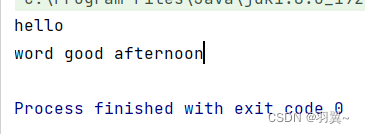
有些特殊字符作为分割符可能无法正确切分, 需要加上转义。
例如:拆分IP地址
String str = "192.168.1.1" ;
String[] result = str.split("\\.") ;
for(String s: result) {
System.out.println(s);}

注意:字符"|","*","+"都得加上转义字符,前面加上 "\\";而如果是 "\" ,那么就得写成 "\\\\";如果一个字符串中有多个分隔符,可以用"|"作为连字符。
多次拆分
public static void main(String[] args) {
String str = "name=zhangsan&age=18";
String[] s1=str.split("&");
for (int i = 0; i < s1.length; i++) {
String[] s2=s1[i].split("=");
for (String ch:s2) {
System.out.println(ch);
}
}
}
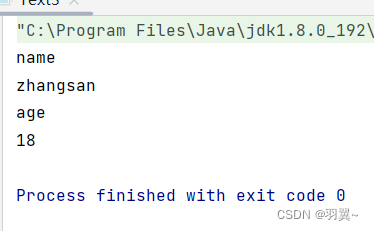
2.6字符串的截取
从一个完整的字符串之中截取出部分内容。
| 方法 | 功能 |
| String substring(int beginIndex) | 从指定索引截取到结尾 |
| String substring(int beginIndex, int endIndex) | 截取部分内容 |
public static void main(String[] args) {
String s="helloworld";
System.out.println(s.substring(3));
System.out.println(s.substring(2,5));//左闭右开
}

2.7 其他操作方法
| 方法 | 功能 |
| String trim() | 去掉字符串中的左右空格,保留中间空格 |
String st=" hello world ";
System.out.println("["+st+"]");
System.out.println("["+st.trim()+"]");
trim 会去掉字符串开头和结尾的空白字符(空格, 换行, 制表符等).

2.8 字符串修改
尽量避免直接对String类型对象进行修改,因为String类是不能修改的,所有的修改都会创建新对象,效率非常低下。
public static void main(String[] args) {
String s = "hello";
s += " world";
System.out.println(s); // 输出:hello world
}
这种方式不推荐使用,如果要修改建议尽量使用StringBuffer或者StringBuilder。
2.9 StringBuilder和StringBuffer
由于String的不可更改特性,为了方便字符串的修改,Java中又提供StringBuilder和StringBuffer类。这两个类大部分功能是相同的,这里介绍 StringBuilder常用的一些方法。
| 方法 | 说明 |
| StringBuff append(String str) |
在尾部追加,相当于String的+=,可以追加:boolean、char、char[]、 double、float、int、long、Object、String、StringBuff的变量 |
| char charAt(int index) | 获取index位置的字符 |
| int length() | 获取字符串的长度 |
| int capacity() | 获取底层保存字符串空间总的大小 |
| void ensureCapacity(int mininmumCapacity) |
扩容 |
| void setCharAt(int index, char ch) |
将index位置的字符设置为ch |
| int indexOf(String str) | 返回str第一次出现的位置 |
| int indexOf(String str, int fromIndex) |
从fromIndex位置开始查找str第一次出现的位置 |
| int lastIndexOf(String str) | 返回最后一次出现str的位置 |
| int lastIndexOf(String str, int fromIndex) |
从fromIndex位置开始找str最后一次出现的位置 |
| StringBuff insert(int offset, String str) |
在offset位置插入:八种基类类型 或 String类型 或Object类型数据 |
| StringBuffer deleteCharAt(int index) |
删除index位置字符 |
| StringBuffer delete(int start, int end) |
删除[start, end)区间内的字符 |
| StringBuffer replace(int start, int end, String str) |
将[start, end)位置的字符替换为str |
| String substring(int start) | 从start开始一直到末尾的字符以String的方式返回 |
| String substring(int start,int end) |
将[start, end)范围内的字符以String的方式返回 |
| StringBuffer reverse() | 反转字符串 |
| String toString() | 将所有字符按照String的方式返回 |
public static void main(String[] args) {
StringBuilder sb1 = new StringBuilder("hello");
StringBuilder sb2 = sb1;
// 追加:即尾插-->字符、字符串、整形数字sb1.append(' '); // hello
sb1.append("world"); // hello world
sb1.append(123); // hello world123
System.out.println(sb1); // hello world123
System.out.println(sb1 == sb2); // true
System.out.println(sb1.charAt(0)); // 获取0号位上的字符 h
System.out.println(sb1.length()); // 获取字符串的有效长度14
System.out.println(sb1.capacity()); // 获取底层数组的总大小
sb1.setCharAt(0, 'H'); // 设置任意位置的字符 Hello world123// 在对应位置插入字符串
sb1.insert(0, "Hello world!!!");//Hello world!!!Hello world123
System.out.println(sb1);
System.out.println(sb1.indexOf("Hello")); // 获取Hello第一次出现的位置
System.out.println(sb1.lastIndexOf("hello")); // 获取hello最后一次出现的位置
sb1.deleteCharAt(0); // 删除首字符
sb1.delete(0,5); // 删除[0, 5)范围内的字符
String str = sb1.substring(0, 5); // 截取[0, 5)区间中的字符以String的方式返回
System.out.println(str);
sb1.reverse(); // 字符串逆转
str = sb1.toString(); // 将StringBuffer以String的方式返回
System.out.println(str)}
String和StringBuilder最大的区别在于String的内容无法修改,而StringBuilder的内容可以修改。频繁修改字符串的情况考虑使用StringBuilder。
注意:String和StringBuilder类不能直接转换。如果要想互相转换,可以采用如下原则:
- String变为StringBuilder: 利用StringBuilder的构造方法或append()方法
- StringBuilder变为String: 调用toString()方法
三、面试题
1. String、StringBuffer、StringBuilder的区别
String的内容不可修改,StringBuffer与StringBuilder的内容可以修改;StringBuffer与StringBuilder大部分功能是相似的;StringBuffer采用同步处理,属于线程安全操作;StringBuilder未采用同步处理,属于线程不安全操作。